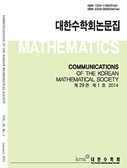Communications of the
Korean Mathematical Society
CKMS
Most Read
 VIEW ARTICLES
VIEW ARTICLES
 Most Read
Most Read
-
2022-10-31
On functions starlike with respect to $n$-ply symmetric, conjugate and symmetric conjugate points
Somya Malik, Vaithiyanathan RavichandranAbstract : For given non-negative real numbers $\alpha_k$ with $ \sum_{k=1}^{m}\alpha_k =1$ and normalized analytic functions $f_k$, $k=1,\dotsc,m$, defined on the open unit disc, let the functions $F$ and $F_n$ be defined by $ F(z):=\sum_{k=1}^{m}\alpha_k f_k (z)$, and $F_{n}(z):=n^{-1}\sum_{j=0}^{n-1} e^{-2j\pi i/n} F(e^{2j\pi i/n} z)$. This paper studies the functions $f_k$ satisfying the subordination $zf'_{k} (z)/F_{n} (z) \prec h(z)$, where the function $h$ is a convex univalent function with positive real part. We also consider the analogues of the classes of starlike functions with respect to symmetric, conjugate, and symmetric conjugate points. Inclusion and convolution results are proved for these and related classes. Our classes generalize several well-known classes and the connections with the previous works are indicated.
-
2022-10-31
On strong exponential limit shadowing property
Ali DarabiAbstract : In this study, we show that the strong exponential limit shadowing property (SELmSP, for short), which has been recently introduced, exists on a neighborhood of a hyperbolic set of a diffeomorphism. We also prove that $\Omega$-stable diffeomorphisms and $\mathcal{\mathcal{L}}$-hyperbolic homeomorphisms have this type of shadowing property. By giving examples, it is shown that this type of shadowing is different from the other shadowings, and the chain transitivity and chain mixing are not necessary for it. Furthermore, we extend this type of shadowing property to positively expansive maps with the shadowing property.
-
2022-10-31
Common fixed point results for generalized orthogonal $F$-Suzuki contraction for family of multivalued mappings in orthogonal $b$-metric spaces
Bahru Tsegaye Leyew, Oluwatosin Temitope MewomoAbstract : In this paper, we introduce a new class of mappings called the generalized orthogonal $F$-Suzuki contraction for a family of multivalued mappings in the setup of orthogonal $b$-metric spaces. We established the existence of some common fixed point results without using any commutativity condition for this new class of mappings in orthogonal $b$-metric spaces. Moreover, we illustrate and support these common fixed point results with example. The results obtained in this work generalize and extend some recent and classical related results in the existing literature.
-
2023-04-30
The measurability of Hewitt-Stromberg measures and dimensions
Zied Douzi, Bilel Selmi, Haythem ZyoudiAbstract : The aim of this paper is to study the descriptive set-theoretic complexity of the Hewitt-Stromberg measure and dimension maps.
-
2023-04-30
Results associated with the Schwarz lemma on the boundary
B\"{u}lent Nafi \"{O}rnekAbstract : In this paper, some estimations will be given for the analytic functions belonging to the class $\mathcal{R}\left( \alpha \right) $. In these estimations, an upper bound and a lower bound will be determined for the first coefficient of the expansion of the analytic function $h(z)$ and the modulus of the angular derivative of the function $\frac{zh^{\prime }(z)}{ h(z)}$, respectively. Also, the relationship between the coefficients of the analytical function $h(z)$ and the derivative mentioned above will be shown.
-
2022-10-31
Riemannian submersions whose total space is endowed with a torse-forming vector field
\c{S}emsi Eken~Meri\c{c}, Erol K{\i}l{\i}\c{c}Abstract : In the present paper, a Riemannian submersion $\pi$ between Riemannian manifolds such that the total space of $\pi$ endowed with a torse-forming vector field $\nu$ is studied. Some remarkable results of such a submersion whose total space is Ricci soliton are given. Moreover, some characterizations about any fiber of $\pi$ or the base manifold $B$ to be an almost quasi-Einstein are obtained.
-
2022-10-31
Certain image formulas of $(p,\nu)$--extended Gauss' hypergeometric function and related Jacobi transforms
Purnima Chopra, Mamta Gupta, Kanak ModiAbstract : Our aim is to establish certain image formulas of the $ (p,\nu)$--extended Gauss' hypergeometric function $F_{\,p,\nu}(a,b;c;z)$ by using Saigo's hypergeometric fractional calculus (integral and differential) operators. Corresponding assertions for the classical Riemann-Liouville(R-L) and Erd\'elyi-Kober(E-K) fractional integral and differential operators are deduced. All the results are represented in terms of the Hadamard product of the $ (p,\nu)$--extended Gauss's hypergeometric function $F_{\,p,\nu}(a,b;c;z)$ and Fox-Wright function $_{r}\Psi_{s}(z)$. We also established Jacobi and its particular assertions for the Gegenbauer and Legendre transforms of the $ (p,\nu)$--extended Gauss' hypergeometric function $F_{\,p,\nu}(a,b;c;z)$.
-
2023-07-31
On nonnil-SFT rings
Ali Benhissi, Abdelamir DabbabiAbstract : The purpose of this paper is to introduce a new class of rings containing the class of SFT-rings and contained in the class of rings with Noetherian prime spectrum. Let $A$ be a commutative ring with unit and $I$ be an ideal of $A$. We say that $I$ is SFT if there exist an integer $k\geq 1$ and a finitely generated ideal $F\subseteq I$ of $A$ such that $x^k\in F$ for every $x\in I$. The ring $A$ is said to be nonnil-SFT, if each nonnil-ideal (i.e., not contained in the nilradical of $A$) is SFT. We investigate the nonnil-SFT variant of some well known theorems on SFT-rings. Also we study the transfer of this property to Nagata's idealization and the amalgamation algebra along an ideal. Many examples are given. In fact, using the amalgamation construction, we give an infinite family of nonnil-SFT rings which are not SFT.
-
2022-07-31
Commutativity criteria of prime rings involving two endomorphisms
Souad Dakir, Abdellah Mamouni, Mohammed TamekkanteAbstract : This paper treats the commutativity of prime rings with involution over which elements satisfy some specific identities involving endomorphisms. The obtained results cover some well-known results. We show, by given examples, that the imposed hypotheses are necessary.
-
2023-10-31
On graded $(m, n)$-closed submodules
Rezvan VarmazyarAbstract : Let $A$ be a $G$-graded commutative ring with identity and $M$ a graded $A$-module. Let $m, n$ be positive integers with $m>n$. A proper graded submodule $L$ of $M$ is said to be graded $(m, n)$-closed if $a^{m}_g\cdot x_t\in L$ implies that $a^{n}_g\cdot x_t\in L$, where $a_g\in h(A)$ and $x_t\in h(M)$. The aim of this paper is to explore some basic properties of these class of submodules which are a generalization of graded $(m, n)$-closed ideals. Also, we investigate $GC^{m}_n-rad$ property for graded submodules.

Most Read
-
Miao-Tam equation on almost coK"{a}hler manifolds
Tarak Mandal
Commun. Korean Math. Soc. 2022; 37(3): 881-891
https://doi.org/10.4134/CKMS.c210225 -
Fekete-Szeg"{o} inequalities for a new general subclass of analytic functions involving the $left( p,qight)$-derivative operator
Serap Bulut
Commun. Korean Math. Soc. 2022; 37(3): 723-734
https://doi.org/10.4134/CKMS.c210196 -
Multi-derivations and some approximations
Abasalt Bodaghi, Hassan Feizabadi
Commun. Korean Math. Soc. 2022; 37(3): 801-812
https://doi.org/10.4134/CKMS.c210300 -
Uniqueness of meromorphic function with its $k$-th derivative sharing two small functions under different weights
Abhijit Banerjee, Arpita Kundu
Commun. Korean Math. Soc. 2023; 38(2): 525-545
https://doi.org/10.4134/CKMS.c220168
Most Downloaded
-
Results concerning semi-symmetric metric $F$-connections on the Hsu-$B$ manifolds
Uday Chand De, Aydin Gezer, Cagri Karaman
Commun. Korean Math. Soc. 2023; 38(3): 837-846
https://doi.org/10.4134/CKMS.c220031 -
A variant of Wilson's functional equation on semigroups
YOUSSEF ASERRAR, ABDELLATIF CHAHBI, ELHOUCIEN ELQORACHI
Commun. Korean Math. Soc. 2023; 38(4): 1063-1074
https://doi.org/10.4134/CKMS.c220315 -
Joint essential numerical spectrum and Jeribi essential numerical spectrum of linear operators in Banach spaces
Bouthaina Abdelhedi, Wissal Boubaker, Nedra Moalla
Commun. Korean Math. Soc. 2023; 38(4): 1029-1044
https://doi.org/10.4134/CKMS.c220019 -
Areas of polygons with vertices from Lucas sequences on a plane
SeokJun Hong, SiHyun Moon, Ho Park, SeoYeon Park, SoYoung Seo
Commun. Korean Math. Soc. 2023; 38(3): 695-704
https://doi.org/10.4134/CKMS.c220245
Editorial Office
CKMS
© 2022. The Korean Mathematical Society. Powered by INFOrang Co., Ltd






